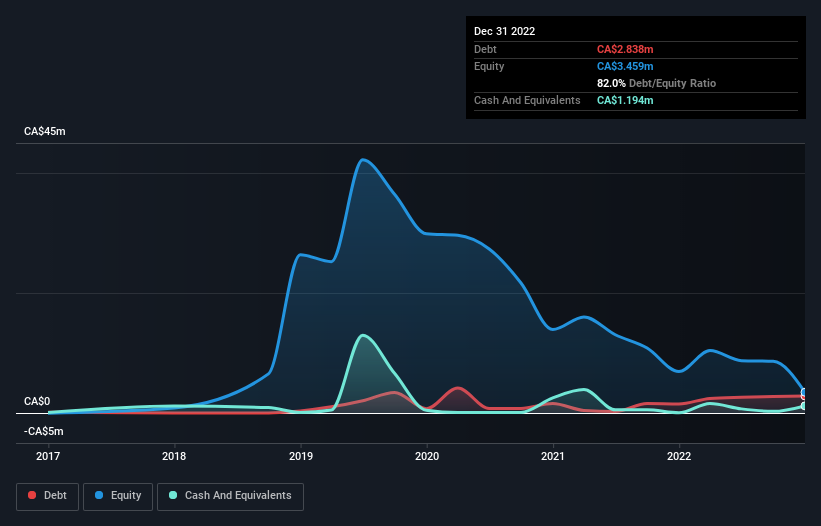
The external fund manager backed by Berkshire Hathaway's Charlie Munger, Li Lu, makes no bones about it when he says 'The biggest investment risk is not the volatility of prices, but whether you will suffer a permanent loss of capital.' So it might be obvious that you need to consider debt, when you think about how risky any given stock is, because too much debt can sink a company. As with many other companies Avicanna Inc. (TSE:AVCN) makes use of debt. But should shareholders be worried about its use of debt?
What Risk Does Debt Bring?
Generally speaking, debt only becomes a real problem when a company can't easily pay it off, either by raising capital or with its own cash flow. Part and parcel of capitalism is the process of 'creative destruction' where failed businesses are mercilessly liquidated by their bankers. However, a more common (but still painful) scenario is that it has to raise new equity capital at a low price, thus permanently diluting shareholders. Of course, the upside of debt is that it often represents cheap capital, especially when it replaces dilution in a company with the ability to reinvest at high rates of return. The first step when considering a company's debt levels is to consider its cash and debt together.
Check out our latest analysis for Avicanna
How Much Debt Does Avicanna Carry?
The image below, which you can click on for greater detail, shows that at December 2022 Avicanna had debt of CA$2.84m, up from CA$1.51m in one year. However, it does have CA$1.19m in cash offsetting this, leading to net debt of about CA$1.64m.

How Strong Is Avicanna's Balance Sheet?
The latest balance sheet data shows that Avicanna had liabilities of CA$11.4m due within a year, and liabilities of CA$2.76m falling due after that. On the other hand, it had cash of CA$1.19m and CA$2.15m worth of receivables due within a year. So its liabilities outweigh the sum of its cash and (near-term) receivables by CA$10.8m.
This deficit isn't so bad because Avicanna is worth CA$33.3m, and thus could probably raise enough capital to shore up its balance sheet, if the need arose. However, it is still worthwhile taking a close look at its ability to pay off debt. The balance sheet is clearly the area to focus on when you are analysing debt. But it is Avicanna's earnings that will influence how the balance sheet holds up in the future. So if you're keen to discover more about its earnings, it might be worth checking out this graph of its long term earnings trend.
In the last year Avicanna wasn't profitable at an EBIT level, but managed to grow its revenue by 24%, to CA$4.0m. Shareholders probably have their fingers crossed that it can grow its way to profits.
Caveat Emptor
While we can certainly appreciate Avicanna's revenue growth, its earnings before interest and tax (EBIT) loss is not ideal. Its EBIT loss was a whopping CA$10m. When we look at that and recall the liabilities on its balance sheet, relative to cash, it seems unwise to us for the company to have any debt. So we think its balance sheet is a little strained, though not beyond repair. However, it doesn't help that it burned through CA$7.5m of cash over the last year. So in short it's a really risky stock. There's no doubt that we learn most about debt from the balance sheet. However, not all investment risk resides within the balance sheet - far from it. For instance, we've identified 5 warning signs for Avicanna (3 don't sit too well with us) you should be aware of.
At the end of the day, it's often better to focus on companies that are free from net debt. You can access our special list of such companies (all with a track record of profit growth). It's free.
New: Manage All Your Stock Portfolios in One Place
We've created the ultimate portfolio companion for stock investors, and it's free.
• Connect an unlimited number of Portfolios and see your total in one currency
• Be alerted to new Warning Signs or Risks via email or mobile
• Track the Fair Value of your stocks
Have feedback on this article? Concerned about the content? Get in touch with us directly. Alternatively, email editorial-team (at) simplywallst.com.
This article by Simply Wall St is general in nature. We provide commentary based on historical data and analyst forecasts only using an unbiased methodology and our articles are not intended to be financial advice. It does not constitute a recommendation to buy or sell any stock, and does not take account of your objectives, or your financial situation. We aim to bring you long-term focused analysis driven by fundamental data. Note that our analysis may not factor in the latest price-sensitive company announcements or qualitative material. Simply Wall St has no position in any stocks mentioned.
About TSX:AVCN
Avicanna
A commercial-stage biopharmaceutical company, engages in the research, development, advancement, and commercialization of evidence-based cannabinoid-based products and formulations for consumer, medical, and pharmaceutical markets in Canada and internationally.
Mediocre balance sheet very low.
Market Insights
Community Narratives



